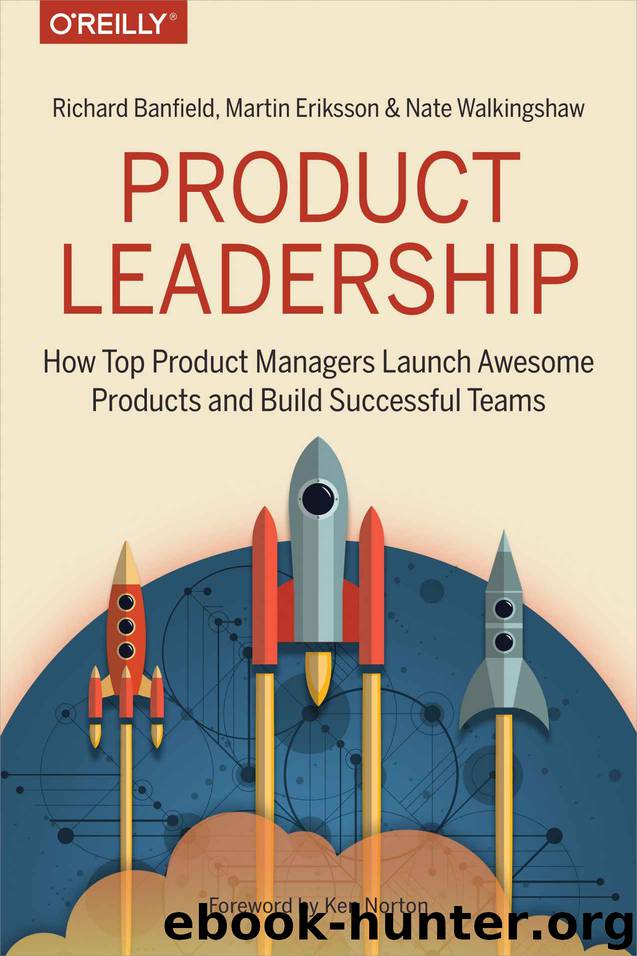Product Leadership: How Top Product Managers Launch Awesome Products and Build Successful Teams by Richard Banfield & Martin Eriksson & Nate Walkingshaw

Author:Richard Banfield & Martin Eriksson & Nate Walkingshaw [Banfield, Richard]
Language: eng
Format: azw3, epub
Publisher: O'Reilly Media
Published: 2017-05-12T04:00:00+00:00
Balancing internal and external drivers
Getting quality feedback from users can be both exciting and overwhelming. Balancing this with internal drivers and ideas is difficult. Not all ideas for improvement need to come from the users. It’s perfectly normal and expected that the product team will have ideas of their own that they will want to implement. So how do you pull this together and determine what your product roadmap is, and what does that problem-solving process look like? How do you process all of that input to determine what goes on your roadmap or priority list?
Jacquelle Amankonah, YouTube’s Global Program Manager, offers this advice: “We cannot do anything or make any decisions without the protection of our creators and our viewers. I’m on the creator team. If I default to creator, that’s why. We use that as not only a data point, but as a starting point for us to determine whether we can balance this priority with our business priorities as well. Maybe there are things that we find are hard for creators or viewers to articulate, but we realize that if we act on this certain technology we can solve this very efficiently for them. We aim to validate that. We may ask, ‘If you could have a magic button that when you press, you end up with this completely automated thing, what would you want that to be?’”
Amankonah knows that posing broad questions to her team and to the user base won’t help identify the right problems. “We definitely don’t just ask, ‘What do we feel like doing, guys?’” she says. “Instead, we start with a prioritized list, a roadmap. We have to make sure that everything we want to do, all of these great ideas, are cadenced in the right way.” Amankonah does this by creating a list of the things they want to design and develop. The team then discusses what the ideal timing would be as those things relate to each other. In other words, will the launch of one thing interfere or add value to another thing? Sometimes features need to launch at the same time to ensure they are adding appropriate value, and sometimes they need to be separated to maintain their integrity. Releasing everything in one batch makes no sense for YouTube because users expect incremental improvements, not sudden and wide-reaching UX changes. “Those are the types of things that we aim to balance so that we have a very clear and cohesive story to the end user,” Amankonah continues. “Even if they’re built on different teams, we all have to work together to make sure we are making one choice as YouTube.”
In developing a roadmap, all of those internal and external nuances have to come into play. What do we have time to do? What can we make time for? How many resources does the team have? What are our users’ most pressing needs? How can we make this happen in a technically interesting and innovative way? Once those questions have been answered, the team can start determining the best path forward.
Download
Product Leadership: How Top Product Managers Launch Awesome Products and Build Successful Teams by Richard Banfield & Martin Eriksson & Nate Walkingshaw.epub
This site does not store any files on its server. We only index and link to content provided by other sites. Please contact the content providers to delete copyright contents if any and email us, we'll remove relevant links or contents immediately.
The Mikado Method by Ola Ellnestam Daniel Brolund(11877)
Hello! Python by Anthony Briggs(11791)
Dependency Injection in .NET by Mark Seemann(11001)
The Well-Grounded Java Developer by Benjamin J. Evans Martijn Verburg(9420)
Sass and Compass in Action by Wynn Netherland Nathan Weizenbaum Chris Eppstein Brandon Mathis(8808)
Secrets of the JavaScript Ninja by John Resig Bear Bibeault(8594)
Svelte with Test-Driven Development by Daniel Irvine(8083)
Test-Driven Development with PHP 8 by Rainier Sarabia(7838)
Layered Design for Ruby on Rails Applications by Dementyev Vladimir;(7651)
Secrets of the JavaScript Ninja by John Resig & Bear Bibeault(7408)
Kotlin in Action by Dmitry Jemerov(7263)
Web Development with Django by Ben Shaw Saurabh Badhwar(7149)
React Application Architecture for Production by Alan Alickovic(6845)
Jquery UI in Action : Master the concepts Of Jquery UI: A Step By Step Approach by ANMOL GOYAL(6447)
Software Architecture for Web Developers by Mihaela Roxana Ghidersa(4947)
Audition by Ryu Murakami(4850)
Accelerating Server-Side Development with Fastify by Manuel Spigolon Maksim Sinik & Matteo Collina(4805)
Solidity Programming Essentials by Ritesh Modi(4529)
Hands-On Full-Stack Web Development with GraphQL and React by Sebastian Grebe(4412)
